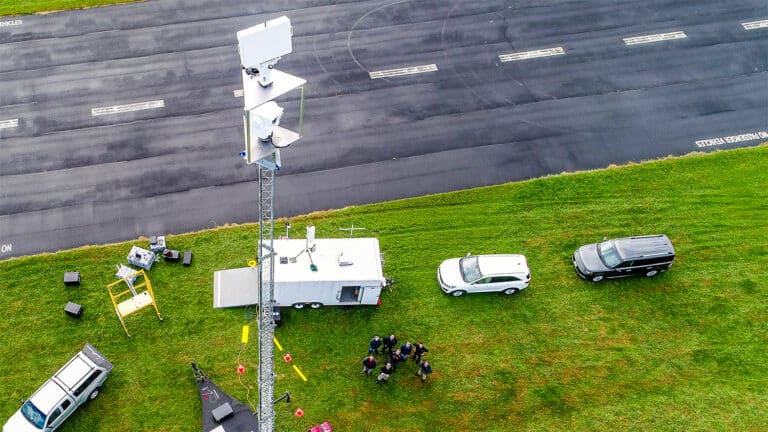Drones Revolutionize Oyster Reef Surveying with Efficiency and Accuracy

In early 2021, a drone flew at about 100 feet over the Gulf waters at a speed of 13 mph while emitting 700,000 laser pulses per second as it surveyed an oyster reef off the Big Bend Coast of Western Florida.
After completing the drone mission, the operators downloaded the data from the unmanned aircraft and processed it to obtain crucial information about the reef’s health.
Oyster reefs, crucial sources of food, jobs, habitat, shore protection, and water purification, are experiencing severe declines along the U.S. Gulf and Atlantic coasts due to overharvesting and environmental stressors.
Traditional methods of identifying reefs at risk of collapse can be labor-intensive and impractical. However, drones are revolutionizing this process.

Michael Espriella, a postdoctoral researcher at the University of Florida, explains, “In the time it takes a person to measure just one or two square meters of reef, you can survey the entire reef structure with a drone.”
Espriella and his colleagues at the University of Florida have discovered that drone-based lidar-generated digital elevation maps can determine an oyster reef’s condition more accurately and efficiently than manual surveys. This means more reefs can be surveyed rapidly, allowing resource managers to intervene before a reef vanishes.
Espriella highlights the value of drone surveys in detecting early signs of deterioration, stating, “With enough surveys of reefs around the state, managers could dig deeper into specific situations and hopefully prevent larger collapses.”
Oyster bed collapses have led to the closure of fisheries, as seen in Florida’s Apalachicola Bay, where oyster harvesting was halted for five years in 2020 to address the damage.
Espriella and his team have long sought a better method for measuring oyster reefs’ condition. The traditional approach involves walking on the reefs at low tide, placing a square grid on a section of the reef, and manually counting live oysters within one square meter of space.
The manual process takes over ten minutes and only covers a small part of a reef. In contrast, a drone flyover of an entire reef takes roughly the same amount of time as a single manual count, making it far more efficient. Lidar scans are then used to generate a three-dimensional model of the reef.
In the report the team explains how they use a DJI Matrice 600 Pro with a LIDAR sensor to survey the oyster banks:
UAS lidar was collected over Little Trout Creek using a DJI Matrice M600 Pro equipped with a Velodyne (San Jose, California, USA) HDL-32e lidar sensor (Fig. 3). This sensor uses 32 beams and emits about 700,000 laser pulses per second with a vertical accuracy of ±2 cm. The sensor uses a near-infrared wavelength of 905 nm. Although water absorbs infrared wavelengths, near-infrared lasers have performed well when used on exposed, wet oysters (Ridge et al., 2023). The preprogrammed survey was flown at an altitude of 30 m with 50% sidelap (i.e., overlap between scanning swaths) and a 90° across-track field of view. Flying at 30 m allows for an appropriate point density for the targeted 1 cm DSM. Setting sidelap to 50% ensures 100% total overlap (excluding the outermost flightlines), limiting data gaps and shadows (Mitchell et al., 2018). The lidar scanner is part of an integrated UAS lidar mapping payload from Phoenix LiDAR Systems (Austin, Texas, USA) that includes a GNSS receiver and an inertial measurement unit (IMU).
Espriella’s group reportedly found that the reef’s volume correlates well with manual oyster counts.
He explains, “The volume-to-area ratio had the best parallel to ecological patterns and processes.” Espriella also notes that oysters often cluster together and believes there is potential to further explore how volume derived from these models can quantify these patterns.
Espriella collaborated with the University of Florida’s Vincent Lecours, Edward Camp, Andrew Lassiter, Benjamin Wilkinson, Peter Frederick, and the University of Oxford’s Simon Pittman on the analysis. Their findings were published in the journal Ecological Indicators on April 10.
Discover more from DroneXL.co
Subscribe to get the latest posts sent to your email.
Check out our Classic Line of T-Shirts, Polos, Hoodies and more in our new store today!

MAKE YOUR VOICE HEARD
Proposed legislation threatens your ability to use drones for fun, work, and safety. The Drone Advocacy Alliance is fighting to ensure your voice is heard in these critical policy discussions.Join us and tell your elected officials to protect your right to fly.
Get your Part 107 Certificate
Pass the Part 107 test and take to the skies with the Pilot Institute. We have helped thousands of people become airplane and commercial drone pilots. Our courses are designed by industry experts to help you pass FAA tests and achieve your dreams.

Copyright © DroneXL.co 2025. All rights reserved. The content, images, and intellectual property on this website are protected by copyright law. Reproduction or distribution of any material without prior written permission from DroneXL.co is strictly prohibited. For permissions and inquiries, please contact us first. DroneXL.co is a proud partner of the Drone Advocacy Alliance. Be sure to check out DroneXL's sister site, EVXL.co, for all the latest news on electric vehicles.
FTC: DroneXL.co is an Amazon Associate and uses affiliate links that can generate income from qualifying purchases. We do not sell, share, rent out, or spam your email.


















